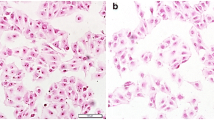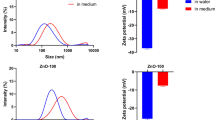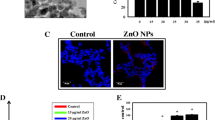Abstract
The aim of the present study is to explore the mechanism of cytotoxic and genotoxic effects of TiO2 nanoparticles on human embryonic kidney (HEK-293) cells. Toxicity was evaluated using changes in various cellular parameters of HEK-293 cells like morphology, viability, metabolic activity, oxidative stress and apoptosis. Oxidative stress was measured by the level of reactive oxygen species (ROS), lipid peroxidation, superoxide dismutase, catalase and glutathione peroxidase. Apoptosis induced by nano-TiO2 was characterized by PI staining and DNA ladder assay. Furthermore, apoptotic proteins such as p53 and Bax were analysed by western blot. Our results indicate that nano-TiO2 induces cytotoxicity in a time- and dose-dependent manner. Oxidative stress and apoptosis were induced by exposure to nano-TiO2. Moreover, the expression of p53, Bax and caspase-3 were increased in a dose-dependent pattern. In conclusion, ROS-mediated oxidative stress, the activation of p53, Bax, caspase-3 and oxidative DNA damage are involved in the mechanistic pathways of nano-TiO2-induced apoptosis in HEK-293 cells.














Similar content being viewed by others
References
Aebi, H. E. (1984). Catalase in vitro. Methods in Enzymology, 105, 121–126.
Barnard, A. S. (2010). One-to-one comparison of sunscreen efficacy, aesthetics and potential nanotoxicity. Nature Nanotechnology, 5, 271–274.
Bhattacharya, K., Davoren, M., Boertz, J., Schins, R., Hoffmann, E., & Dopp, E. (2009). Titanium dioxide nanoparticles induce oxidative stress and DNA-adduct formation but not DNA-breakage in human lung cells. Particle and Fibre Toxicology, 6, 17.
Bradford, M. M. (1976). Rapid and sensitive method for the quantitation of microgram quantities of protein utilizing the principle of protein-dye binding. Analytical Biochemistry, 72, 248–254.
Cardaci, S., Filomeni, G., Rotilio, G., Ciriolo, M. R. (2008). Reactive oxygen species mediated p53 activation and apoptosis induced by sodium nitroprusside in SHSYSY cells. Mol Pharmacol, 74, 1234–1245.
Chen, J. M., Tan, M. G., Nemmar, A., Song, W. M., Dong, M., Zhang, G. L., & Li, Y. (2006). Quantification of extra pulmonary translocation of intratracheal-instilled particles in vivo in rats: effect of lipopolysaccharide. Toxicology, 222, 195–201.
Chan, J., Ying, T., Guang, Y. F., Lin, L. X., Xu, S., Fan, X. Y., Huang, Y. Y., & Yang, Y. J. (2011). Cellular toxicity of TiO2 nanoparticles in anatase and rutile crystal phase. Biological Trace Element Research, 141, 3–15.
Chowdhury, R., Chowdhury, S., Roychoudhury, P., Mandal C., Chaudhuri K. (2009). Arsenic induced apoptosis in malignant melanoma cells is enhanced by menadione through ROS generation, p38 signaling and p53 activation. Apoptosis, 14, 108–123.
Denizot, F., & Lang, R. (1986). Rapid colorimetric assay for cell growth and survival, modifications to the tetrazolium dye procedure giving improved sensitivity and reliability. Journal of Immunological Methods, 89(2), 271–277.
Donaldson, K., Stone, V., Gilmour, P. S., Brown, D. M., & Macnee, W. (2000). Ultrafine particles: mechanisms of lung injury. Philosophical Transactions of the Royal Society of London, Series A: Mathematical, Physical and Engineering Sciences, 358, 2741–2749.
Dreher, K. L. (2004). Health and environmental impact of nanotechnology: toxicological assessment of manufactured nanoparticles. Toxicological Sciences, 77(1), 3–5.
Elbekai, R. H., El-Kadi, A. O. S. (2005). The role of oxidative stress in the modulation of aryl hydrocarbon receptor-regulated genes by As3+, Cd2+ and Cr6+. Free Radic Biol Med, 39, 1499–1511.
Florea, A. M., Splettstoesser, F., & Busselberg, D. (2007). Arsenic trioxide (As2O3) induced calcium signals and cytotoxicity in two human cell lines: SY-5Y neuroblastoma and 293 embryonic kidney (HEK). Toxicology and Applied Pharmacology, 220, 292–301.
Foucaud, L., Wilson, M. R., Brown, D. M., & Stone, V. (2007). Measurement of reactive species production by nanoparticles prepared in biologically relevant media. Toxicology Letters, 174, 1–9.
Galluzzi, L., Blomgren K., Kroemer G. (2009). Mitochondrial membrane permeabilization in neuronal injury. Nat Rev Neurosci, 10(7), 481–494.
Gelis, C., Girard, S., Mavon, A., Delverdier, M., Pailous, N., & Vicendo, P. (2003). Assessment of the skin photo-protective capacities of an organo-mineral broad spectrum sunblock on two ex vivo skin models. Photodermatology, Photoimmunology and Photomedicine, 19(5), 242–253.
Gheshlaghi, Z. N., Riazi, G. H., Ahmadian, S., Ghafari, M., & Mahinpour, R. (2008). Toxicity and interaction of titanium dioxide nanoparticles with microtubule protein. Acta Biochimica et Biophysica Sinica, 40, 777–782.
Gojova, A., Guo, B., Kota, R. S., Rutledge, J. C., Kennedy, I. M., & Barakat, A. I. (2007). Induction of inflammation in vascular endothelial cells by metal oxide nanoparticles: effect of particle composition. Environmental Health Perspectives, 115, 403–409.
Gurr, J., Wang, A. A. S., Chen, C., & Jan, K. (2005). Ultrafine titanium dioxide particles in the absence of photoactivation can induce oxidative damage to human bronchial epithelial cells. Toxicology, 213, 66–73.
Hirakawa, K., Mori, M., Yoshida, M., Oikawa, S., & Kawanishi, S. (2004). Photo-irradiated titanium dioxide catalyzes site specific DNA damage via generation of hydrogen peroxide. Free Radical Research, 38(5), 439–447.
Hirano, S., Kanno, S., & Furuyama, A. (2008). Multi-walled carbon nanotubes injure the plasma membrane of macrophages. Toxicology and Applied Pharmacology, 232, 244–251.
Holly, A. K., St-Clair, D. K. (2009). Watching the watcher: Regulation of p53 by mitochondria. Future Oncol, 5(1), 117–130.
Hussain, S. M., Hess, K. L., Gearhart, J. M., Geiss, K. T., & Schlager, J. J. (2005). In vitro toxicity of nanoparticles in BRL 3A rat liver cells. Toxicology In Vitro, 19, 975–983.
Ishizawa, M., Kobayashi, Y., Miyamura, T., & Matsuura, S. (1991). Simple procedure of DNA isolation from human serum. Nucleic Acids Research, 19, 5792.
Ji, L. L., Chen, Y., & Wang, Z. T. (2008). The toxic effect of pyrrolizidine alkaloid clivorine on the human embryonic kidney 293 cells and its primary mechanism. Experimental and Toxicologic Pathology, 60, 87–93.
Kang, S. J., Kim, B. M., Lee, Y. J., & Chung, H. W. (2008). Titanium dioxide nanoparticles trigger p53-mediated damage response in peripheral blood lymphocytes. Environmental and Molecular Mutagenesis, 49, 399–405.
Kleinman, M. T., Araujo, J. A., Nel, A., Sioutas, C., Campbell, A., Cong, P. Q., Li, H., & Bondy, S. C. (2008). Inhaled ultrafine particulate matter affects CNS inflammatory processes and may act via MAP kinase signaling pathways. Toxicology Letters, 178, 127–130.
Kreyling, W. G., Semmler, M., Erbe, F., Mayer, P., Takenaka, S., Schulz, H., Oberdorster, G., & Ziesenis, A. (2002). Translocation of ultrafine insoluble iridium particles from lung epithelium to extrapulmonary organs is size dependent but very low. Journal of Toxicology and Environmental Health. Part A, 65, 1513–1530.
Kulms, D., Zeise, E., Poppelmann, B., & Schwarz, T. (2002). DNA damage, death receptor activation and reactive oxygen species contribute to ultraviolet radiation induced apoptosis in an essential and independent way. Oncogene, 21, 5844–5851.
Li, S. Q., Zhu, R. R., Zhu, H., Xue, M., Sun, X. Y., Yao, S. D., & Wang, S. L. (2008). Nanotoxicity of TiO2 nanoparticles to erythrocyte in vitro. Food and Chemical Toxicology, 46, 3626–3631.
Lin, W. S., Huang, Y. W., Zhou, X. D., & Ma, Y. F. (2006). In vitro toxicity of silica nanoparticles in human lung cancer cells. Toxicology and Applied Pharmacology, 217, 252–259.
Long, T. C., Tajuba, J., Sama, P., Saleh, N., Swartz, C., Parker, J., Hester, S., Lowry, G. V., & Veronesi, B. (2007). Nanosize titanium dioxide stimulates reactive oxygen species in brain microglia and damages neurons in vitro. Environmental Health Perspectives, 115, 1631–1637.
Low, W. K., Tan, M. G., Sun, L., Chua, A. W., Goh, L. K., & Wang, D. Y. (2006). Dose-dependent radiation-induced apoptosis in a cochlear cell-line. Apoptosis, 11, 2127–2136.
Marklund, S. L., & Marklund, G. (1974). Involvement of the superoxide anion radical in the autooxidation of pyrogallol and a convenient assay of superoxide dismutase. European Journal of Biochemistry, 47, 469–474.
Markovic, Z., Todorovic-Markovic, B., Kleut, D., Nikolic, N., Vranjes-Djuric, S., Misirkic, M., Vucicevic, L., Janjetovic, K., Isakovic, A., Harhaji, L., Babic-Stojic, B., Dramicanin, M., & Trajkovic, V. (2007). The mechanism of cell-damaging reactive oxygen generation by colloidal fullerenes. Biomaterials, 28, 5437–5448.
Medina, C., Santos-Martinez, M. J., Radomski, A., Corrigan, O. I., & Radomski, M. W. (2007). Nanoparticles: pharmacological and toxicological significance. British Journal of Pharmacology, 150, 552–558.
Meena, R., Kesari, K. K., Rani, M., & Paulraj, R. (2012). Effect of hydroxyapatite nanoparticles on proliferation and apoptosis of human breast cancer cells (MCF-7). Journal of Nanoparticle Research, 14, 712.
Mroz, R. M., Schins, R. P., Li, H., Jimenez, L. A., Drost, E. M., Holownia, A., MacNee, W., & Donaldson, K. (2008). Nanoparticle-driven DNA damage mimics irradiation related carcinogenesis pathways. European Respiratory Journal, 31, 241–251.
Nel, A., Xia, T., Madler, L., & Li, N. (2006). Toxic potential of materials at the nanolevel. Science, 311, 622–627.
Nemmar, A., Hoylaerts, M. F., Hoet, P. H., & Nemery, B. (2004). Possible mechanisms of the cardiovascular effects of inhaled particles: systemic translocation and prothrombotic effects. Toxicology Letters, 149, 243–253.
Osano, E., Kishi, J., & Takahashi, Y. (2003). Phagocytosis of titanium particles and necrosis in TNF-alpha-resistant mouse sarcoma L929 cells. Toxicology In Vitro, 17, 41–47.
Pan, Z., Lee, W., Slutsky, L., Clark, R. A., Pernodet, N., & Rafailovich, M. H. (2009). Adverse effects of titanium dioxide nanoparticles on human dermal fibroblasts and how to protect cells. Small, 5, 511–520.
Park, B., Donaldson, K., Duffin, R., Tran, L., Kelly, F., Mudway, I., Morin, J. P., Guest, R., Jenkinson, P., Samaras, Z., Giannouli, M., Kouridis, H., & Martin, P. (2008a). Hazard and risk assessment of a nanoparticulate cerium oxide-based diesel fuel additive—a case study. Inhalation Toxicology, 20, 547–566.
Park, E. J., Choi, J., Park, Y., & Park, K. (2008b). Oxidative stress induced by cerium oxide nanoparticles in cultured BEAS-2B cells. Toxicology, 1(2), 90–100.
Paulraj, R., & Behari, J. (2006). Single strand DNA breaks in rat brain cells exposed to microwave radiation. Mutation Research, 596, 76–80.
Pioletti, D. P., Takei, H., Kwon, S. Y., Wood, D., & Sung, K. L. (1999). The cytotoxic effect of titanium particles phagocytosed by osteoblasts. Journal of Biomedical Materials Research, 46, 399–407.
Pommier, Y., Sordet, O., Antony, S., Hayward, R. L., & Kohn, K. W. (2004). Apoptosis defects and chemotherapy resistance: molecular interaction maps and networks. Oncogene, 23, 2934–2949.
Riccardi, C., & Nicoletti, I. (2006). Analysis of apoptosis by propidium iodide staining and flow cytometry. Nature Protocols, 1, 1458–1461.
Riedl, S. J., & Shi, Y. (2004). Molecular mechanisms of caspase regulation during apoptosis. Nature Reviews Molecular Cell Biology, 5, 897–907.
Roduit, R., & Schorderet, D. F. (2008). MAP kinase pathways in UV-induced apoptosis of retinal pigment epithelium ARPE19 cells. Apoptosis, 13, 343–353.
Sayes, C. M., Gobin, A. M., Ausman, K. D., Mendez, J., West, J. L., & Colvin, V. L. (2005). Nano-C60 cytotoxicity is due to lipid peroxidation. Biomaterials, 26, 7587–7595.
Sun, D., Meng, T. T., Loong, H., & Hwa, T. J. (2004). Removal of natural organic matter from water using a nano-structured photocatalyst coupled with filtrating membrane. Water Science and Technology, 49, 103–110.
Varshney, R., & Kale, R. K. (1990). Effect of calmodulin antagonist on radiation-induced lipid peroxidation in microsomes. International Journal of Radiation Biology, 58, 733–743.
Wang, J. J., Sanderson, B. J., & Wang, H. (2007). Cyto and geno-toxicity of ultrafine TiO2 particles in cultured human lymphoblastoid cells. Mutation Research, 628, 99–106.
Wang, M. L., Tuli, R., Manner, P. A., Sharkey, P. F., Hall, D. J., & Tuan, R. S. (2003). Direct and indirect induction of apoptosis in human mesenchymal stem cells in response to titanium particles. Journal of Orthopaedic Research, 21, 697–707.
Xia, T. (2006). Comparison of the abilities of ambient and manufactured nanoparticles to induce cellular toxicity according to an oxidative stress paradigm. Nano Letters, 6(8), 1794–1807.
Xing, Y. X., Li, P., Miao, Y. X., Du, W., & Wang, C. B. (2008). Involvement of ROS/ASMase/JNK signalling pathway in inhibiting UVA-induced apoptosis of HaCaT cells by polypeptide from Chlamys farreri. Free Radical Research, 42, 12–19.
Acknowledgments
The authors are thankful to Advance Instrumentation Research Facility (AIRF), JNU New Delhi, for confocal microscopy, transmission electron microscopy, scanning electron microscopy and EDXRF instruments.
Author information
Authors and Affiliations
Corresponding author
Rights and permissions
About this article
Cite this article
Meena, R., Rani, M., Pal, R. et al. Nano-TiO2-Induced Apoptosis by Oxidative Stress-Mediated DNA Damage and Activation of p53 in Human Embryonic Kidney Cells. Appl Biochem Biotechnol 167, 791–808 (2012). https://doi.org/10.1007/s12010-012-9699-3
Received:
Accepted:
Published:
Issue Date:
DOI: https://doi.org/10.1007/s12010-012-9699-3




